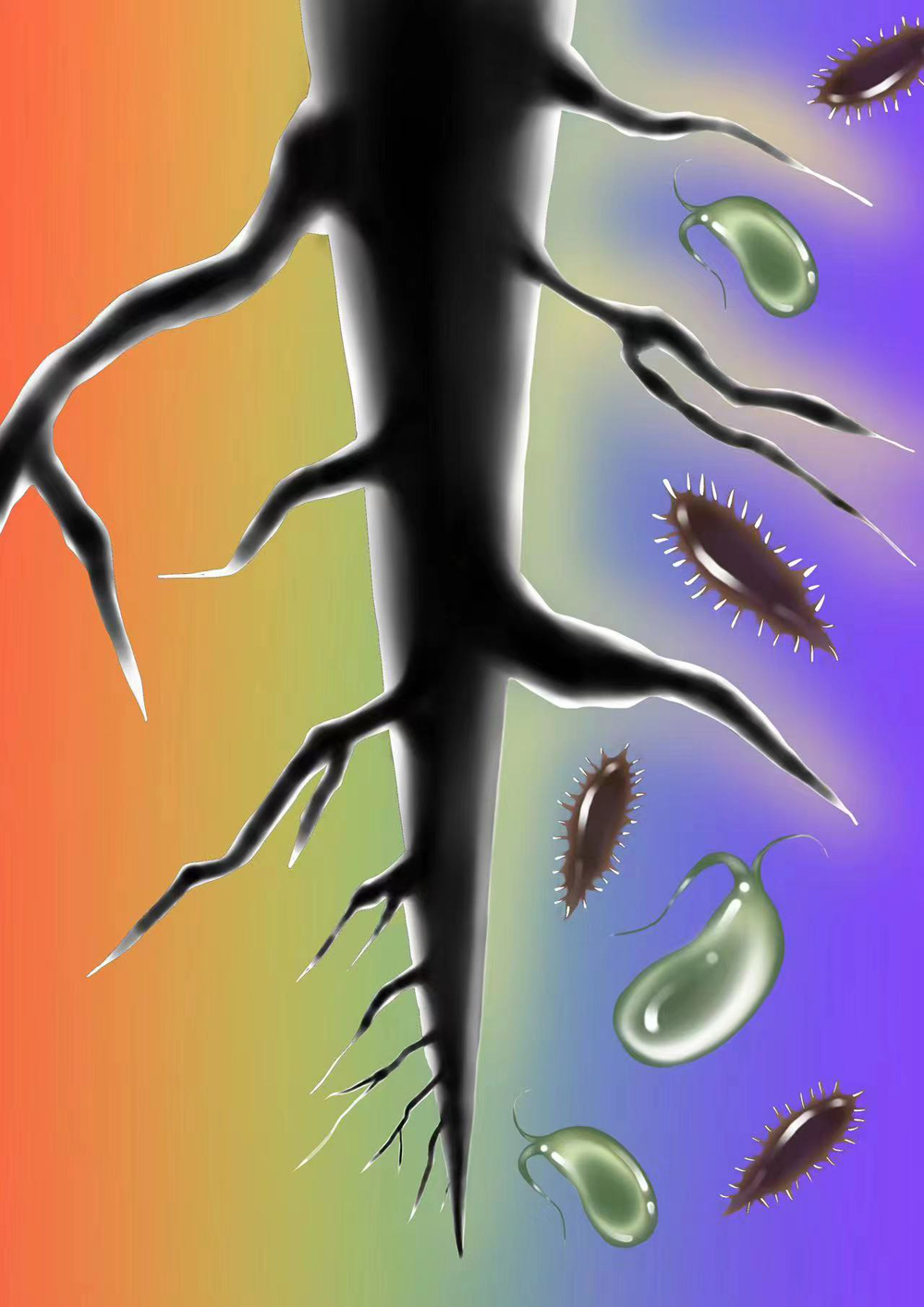

Analysis of the pH Sensing Mechanism of Plant Apoplasts
Received date: 2022-08-19
Revised date: 2022-08-22
Online published: 2022-08-23
The apoplast is the frontier area for plants to sense and respond to environmental stresses (including biotic and abiotic stresses). The pH of the apoplast is an important physiological parameter that is tightly regulated. Environmental stress (such as bacterial disease) can cause alkalinization of plant apoplast, but how does apoplast pH coordinate root growth and immune response? Its molecular regulation mechanism is still unclear. Recently, the team of Professor Hongwei Guo from the School of Life Sciences, Southern University of Science and Technology, and the team of Professor Jijie Chai from Tsinghua University-Max Planck Institute of Germany-University of Cologne used the model plant Arabidopsis as research materials, through genetic, cellular, biochemical and structural biology. By means of comprehensive methods, it was found that the small peptide-receptor complex on the cell surface can act as an apoplast pH sensor to sense and respond to the apoplast alkalinization of Arabidopsis root apex meristem cells induced by pattern triggered immunity (PTI). The results of this research have discovered the protein complex and response mechanism of plant root apex meristem apoplast pH sensing, as well as the coordination mechanism between immunity and growth, further understanding the biology reaction process of how plants balance growth and immune response.

Key words: Arabidopsis thaliana; apoplast pH; receptor
Yang Yongqing , Guo Yan . Analysis of the pH Sensing Mechanism of Plant Apoplasts[J]. Chinese Bulletin of Botany, 2022 , 57(4) : 409 -411 . DOI: 10.11983/CBB22198
| [1] | Bacon MA, Wilkinson S, Davies WJ (1998). pH-regulated leaf cell expansion in droughted plants is abscisic acid dependent. Plant Physiol 118, 1507-1515. |
| [2] | Barbez E, Dünser K, Gaidora A, Lendl T, Busch W (2017). Auxin steers root cell expansion via apoplastic pH regulation in Arabidopsis thaliana. Proc Natl Acad Sci USA 114, E4884-E4893. |
| [3] | Blumwald E, Aharon GS, Apse MP (2000). Sodium transport in plant cells. Biochim Biophys Acta 1465, 140-151. |
| [4] | Cao M, Chen R, Li P, Yu YQ, Zheng R, Ge DF, Zheng W, Wang XH, Gu YT, Gelová Z, Friml J, Zhang H, Liu RY, He J, Xu TD (2019). TMK1-mediated auxin signaling regulates differential growth of the apical hook. Nature 568, 240-243. |
| [5] | Felle HH, Herrmann A, Hanstein S, Hückelhoven R, Kogel KH (2004). Apoplastic pH signaling in barley leaves attacked by the powdery mildew fungus Blumeria graminis f. sp. hordei. Mol Plant Microbe Interact 17, 118-123. |
| [6] | Felle HH, Herrmann A, Hückelhoven R, Kogel KH (2005). Root-to-shoot signaling: apoplastic alkalinization, a gene- ral stress response and defence factor in barley (Hordeum vulgare). Protoplasma 227, 17-24. |
| [7] | Geilfus CM, Tenhaken R, Carpentier SC (2017). Transient alkalinization of the leaf apoplast stiffens the cell wall during onset of chloride salinity in corn leaves. J Biol Chem 292, 18800-18813. |
| [8] | Havshøi NW, Fuglsang AT (2022). A critical review on natural compounds interacting with the plant plasma membrane H+-ATPase and their potential as biologicals in agriculture. J Integr Plant Biol 64, 268-286. |
| [9] | Huffaker A, Ryan CA (2007). Endogenous peptide defense signals in Arabidopsis differentially amplify signaling for the innate immune response. Proc Natl Acad Sci USA 104, 10732-10736. |
| [10] | Li J, Guo Y, Yang YQ (2022). The molecular mechanism of plasma membrane H+-ATPases in plant responses to abiotic stress. J Genet Genomics 30, S1673-8527(22) 00158-8. |
| [11] | Li LX, Verstraeten I, Roosjen M, Takahashi K, Rodriguez L, Merrin J, Chen J, Shabala L, Smet W, Ren H, Vanneste S, Shabala S, De Rybel B, Weijers D, Kinoshita T, Gray WM, Friml J (2021). Cell surface and intracellular auxin signaling for H+ fluxes in root growth. Nature 599, 273-277. |
| [12] | Lin WW, Zhou X, Tang WX, Takahashi K, Pan X, Dai JW, Ren H, Zhu XY, Pan SQ, Zheng HY, Gray WM, Xu TD, Kinoshita T, Yang ZB (2021). TMK-based cell-surface auxin signaling activates cell-wall acidification. Nature 599, 278-282. |
| [13] | Liu L, Song W, Huang SJ, Jiang K, Moriwaki Y, Wang YC, Men YF, Zhang D, Wen X, Han ZF, Chai JJ, Guo HW (2022). Extracellular pH sensing by plant cell-surface peptide-receptor complexes. Cell doi: 10.1016/j.cell.2022.07.012. |
| [14] | Martinière A, Gibrat R, Sentenac H, Dumont X, Gaillard I, Paris N (2018). Uncovering pH at both sides of the root plasma membrane interface using noninvasive imaging. Proc Natl Acad Sci USA 115, 6488-6493. |
| [15] | Motomitsu A, Sawa S, Ishida T (2015). Plant peptide hormone signaling. Essays Biochem 58, 115-131. |
| [16] | Osakabe Y, Yamaguchi-Shinozaki K, Shinozaki K, Tran LS (2013). Sensing the environment: key roles of membrane-localized kinases in plant perception and response to abiotic stress. J Exp Bot 64, 445-458. |
| [17] | Yang YQ, Guo Y (2018). Elucidating the molecular mechanisms mediating plant salt-stress responses. New Phytol 217, 523-539. |
/
| 〈 |
|
〉 |